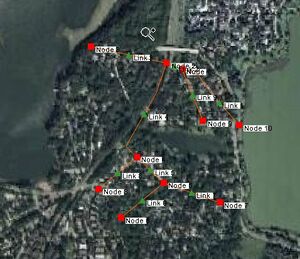WMS:Conceptual Model: Difference between revisions
From XMS Wiki
Jump to navigationJump to search
No edit summary |
No edit summary |
||
| Line 1: | Line 1: | ||
A | [[File:SWMMHydraulicSchematicFromStormDrainConceptualModel.jpg|thumb|right|A SWMM hydraulic model with arcs representing links and nodes in a SWMM model and the symbols corresponding to links and nodes in the hydraulic schematic.]] | ||
A '''conceptual model''' is a map-based representation of a hydrologic or hydraulic model using [[WMS:Feature Objects|feature objects]] such as points, nodes, arcs, and polygons. | |||
To define and compute lumped-parameter model data, WMS normally converts a map module representation of the model to a schematic- or tree-based representation of the model in either the hydrologic modeling or river module. | |||
*When creating a conceptual model of ''hydrologic'' data (basins, streams, and outlet points), the schematic representation is created automatically. | |||
[[ | *When creating a conceptual model of ''hydraulic'' data, the schematic representation is created by selecting the [[WMS:Storm Drain#Storm Drain Menu|'''Map→1D Schematic''']] menu item available in the special menu associated with the hydraulic modeling coverage (This command is available in 1D Hydraulic Schematic and Storm Drain coverages). After selecting the '''Map→1D Schematic''' command, cross sections, reaches, links, and/or nodes are displayed as symbols in the river module and their properties can be edited in that module. | ||
| Line 10: | Line 11: | ||
[[Category:WMS Map|C]] | [[Category:WMS Map|C]] | ||
[[Category:Conceptual Model]] | [[Category:Conceptual Model]] | ||
Revision as of 23:22, 19 December 2019
A conceptual model is a map-based representation of a hydrologic or hydraulic model using feature objects such as points, nodes, arcs, and polygons.
To define and compute lumped-parameter model data, WMS normally converts a map module representation of the model to a schematic- or tree-based representation of the model in either the hydrologic modeling or river module.
- When creating a conceptual model of hydrologic data (basins, streams, and outlet points), the schematic representation is created automatically.
- When creating a conceptual model of hydraulic data, the schematic representation is created by selecting the Map→1D Schematic menu item available in the special menu associated with the hydraulic modeling coverage (This command is available in 1D Hydraulic Schematic and Storm Drain coverages). After selecting the Map→1D Schematic command, cross sections, reaches, links, and/or nodes are displayed as symbols in the river module and their properties can be edited in that module.
| [hide] WMS – Watershed Modeling System | ||
|---|---|---|
| Modules: | Terrain Data • Drainage • Map • Hydrologic Modeling • River • GIS • 2D Grid • 2D Scatter |  |
| Models: | CE-QUAL-W2 • GSSHA • HEC-1 • HEC-HMS • HEC-RAS • HSPF • MODRAT • NSS • OC Hydrograph • OC Rational • Rational • River Tools • Storm Drain • SMPDBK • SWMM • TR-20 • TR-55 | |
| Toolbars: | Modules • Macros • Units • Digitize • Static Tools • Dynamic Tools • Drawing • Get Data Tools | |
| Aquaveo | ||
